Everyone deserves a safe home in which to live, work, care for their families and be able to make plans for their future. Yet, more than seven years after the Grenfell Tower fire, an estimated 600,000 people will go to bed tonight in homes that are still unsafe, and almost 3 million are trapped with unsellable homes, unable to move on with their lives, according to recent analysis by the Sunday Times. More than 15,000 residents have been ordered to leave their unsafe homes since Grenfell, and evacuations are on the rise.
Justice has been a long time coming for the bereaved, residents and survivors of Grenfell. The Grenfell Tower Inquiry will publish its Phase II report on 4th September, which is an important step in holding individuals and organisations to account for the loss of 72 innocent lives, but criminal trials are not expected to begin until at least 2027, ten years after the fire. Shockingly, the pace of removing cladding and other fire safety defects from flats across the country has been even slower – and at the current rate, it could take decades.
The previous Government rarely acknowledged the full scale of buildings affected, but estimates published in July show that 11,000 buildings are expected to require remediation works, including 2,414 managed by social housing providers. Despite this, the latest official statistics report that only 4,630 buildings are being actively monitored or “in programme.” Cladding has been removed from 1,350 buildings: just 12% of the estimated total. The government has committed £9.2bn of funding, but only £2.3bn (25%) has been spent so far.
Being “in negotiations” about remediation or having “plans in place” counts for little when dangerous cladding – or other construction defects that enable fire to spread rapidly – remain on people’s homes. Let’s not forget, these defects are defined as “life-critical.” Recent cladding fires, from Wembley to Valencia, have demonstrated why action remains so urgent.
When Grenfell survivors gave evidence to parliament a year after the fire, they warned MPs that :
“Grenfell 2 is in the post unless you act, and quickly… The Government need to take responsibility… There needs to be a plan, and it needs to be acted on right now.”
In Opposition, Labour agreed. Back in 2021, Sir Keir Starmer shared his plan to end the cladding scandal. He was adamant that Boris Johnson, then Prime Minister, “could end this scandal right now if he wanted to. The Government must end the delay and give innocent homeowners the safety and security that they deserve.” Now, with a new Labour Government in power, there is no time to lose in getting a grip of this crisis.
Since day one, the pledge to build 1.5 million new homes in this Parliament and to “get Britain building again” has been front and centre in Labour’s messaging. However, residents and leaseholders are still waiting anxiously to hear the same kind of commitment and clear deadline for making existing homes safe.
The Minister for Building Safety and Homelessness, Rushanara Ali, has written to property developers about her intention to convene a roundtable, to agree a plan for accelerating remediation. This is welcome, but what is needed is firm action to hold all parties to account, with clear deadlines and real consequences for delays. Otherwise, building profitable new homes will continue to take precedence over making existing homes safe, leaseholders and residents will remain trapped, and the market for flats will remain broken.
Labour must focus not just on the pace but also on the quality of remediation, ensuring that the scope of works is not being minimised by developer-commissioned assessments which leave combustible materials and other defects in place, because this leaves leaseholders and residents with higher risks, higher costs, and potentially unsellable homes forever.
The current developer remediation contract covers only 15% of the 11,000 buildings expected to require remedial work. Therefore, the same urgent focus must be applied to government-led remediation programmes, and a wider pool of developers, contractors and freeholders should be compelled to make all their buildings safe. That does not just mean external cladding; internal building safety defects must also be addressed, because buildings cannot be made half-safe.
The End Our Cladding Scandal campaign has published a manifesto, outlining five key focus areas for the new Government to finally end the crisis:
- Establish clear and comprehensive risk assessment standards. Definitive, holistic, and risk-based guidance is essential for buildings of all heights and for both external and internal defects, so that safety assessments and the remediation required will be absolutely clear and consistent.
- Make homes safe at the pace residents need and deserve. The pace of work must significantly accelerate from today. The government, construction industry and building owners must all be held to account to ensure a swift solution.
- All leaseholders must be fully protected from the cost of remedying safety defects. The building safety crisis is the result of a decades-long collective failure by the construction industry and successive Governments that ignored warnings that the building regime was not fit for purpose. Every leaseholder is blameless and should have equal protection.
- Protection from further financial penalties. The government must ensure leaseholders affected by this national scandal are not further penalised by an onerous mortgage lending process and exorbitant building insurance premiums.
- Urgent action to give people their lives back – now. Those affected must be able to obtain accurate information about their homes, remediation work must be carried out with respect for residents, and mental health support must be available to those affected.
We cannot wait for Grenfell 2 before we act. The new government has an opportunity to step up and deliver a much fairer and faster end to the building safety crisis – and it is time to grasp the nettle.
